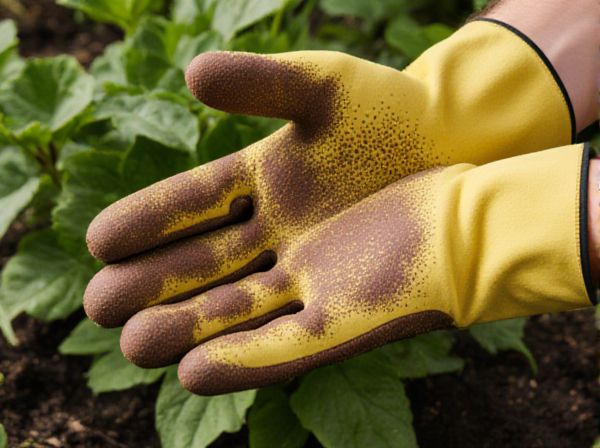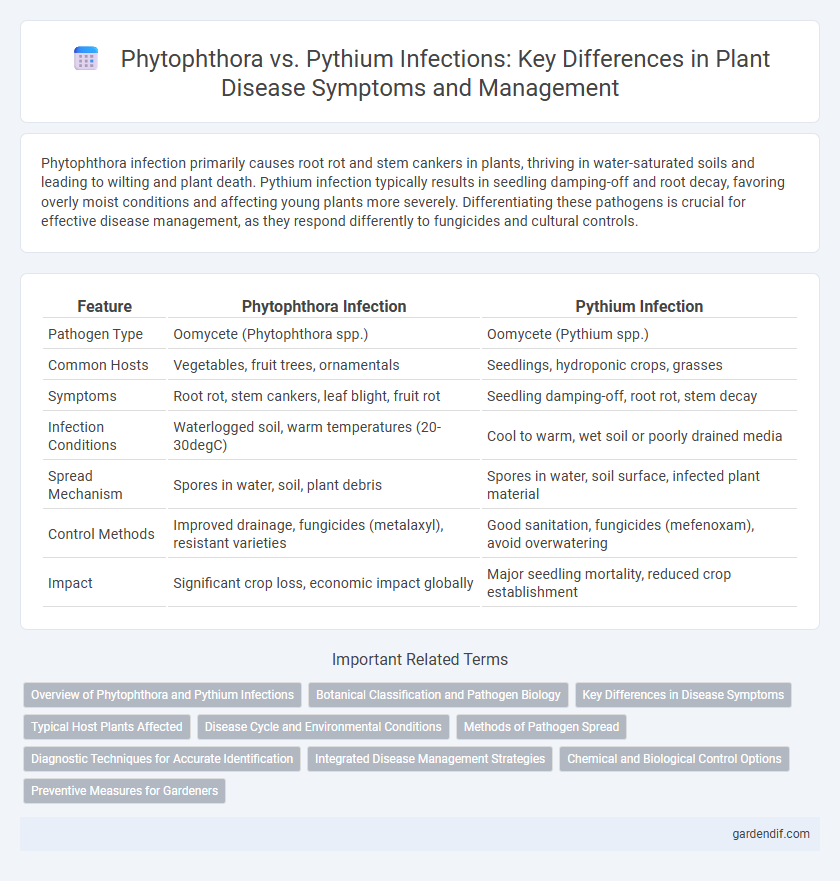
Phytophthora infection vs Pythium infection Illustration
Phytophthora infection primarily causes root rot and stem cankers in plants, thriving in water-saturated soils and leading to wilting and plant death. Pythium infection typically results in seedling damping-off and root decay, favoring overly moist conditions and affecting young plants more severely. Differentiating these pathogens is crucial for effective disease management, as they respond differently to fungicides and cultural controls.
Table of Comparison
| Feature | Phytophthora Infection | Pythium Infection |
|---|---|---|
| Pathogen Type | Oomycete (Phytophthora spp.) | Oomycete (Pythium spp.) |
| Common Hosts | Vegetables, fruit trees, ornamentals | Seedlings, hydroponic crops, grasses |
| Symptoms | Root rot, stem cankers, leaf blight, fruit rot | Seedling damping-off, root rot, stem decay |
| Infection Conditions | Waterlogged soil, warm temperatures (20-30degC) | Cool to warm, wet soil or poorly drained media |
| Spread Mechanism | Spores in water, soil, plant debris | Spores in water, soil surface, infected plant material |
| Control Methods | Improved drainage, fungicides (metalaxyl), resistant varieties | Good sanitation, fungicides (mefenoxam), avoid overwatering |
| Impact | Significant crop loss, economic impact globally | Major seedling mortality, reduced crop establishment |
Overview of Phytophthora and Pythium Infections
Phytophthora infections primarily cause root rot, stem cankers, and damping-off in plants, characterized by dark, water-soaked lesions and rapid tissue decay. Pythium infections typically lead to seedling damping-off and root rot, with symptoms including soft, mushy roots and a failure of seedlings to emerge or thrive. Both pathogens are oomycetes thriving in moist environments, but Phytophthora species often infect mature plants, while Pythium species commonly target seedlings and young plants.
Botanical Classification and Pathogen Biology
Phytophthora belongs to the Oomycetes class within the Stramenopiles, characterized by non-septate hyphae and producing zoospores with two unequal flagella, while Pythium is also an Oomycete but typically exhibits faster growth and produces abundant, spiny-walled oospores. Phytophthora species are notorious for causing serious vascular diseases by colonizing plant roots and stems, often forming resistant chlamydospores, whereas Pythium primarily causes damping-off and root rot with rapid hyphal penetration of root tissues. Both pathogens thrive in moist environments but differ in their host range specificity and survival structures, impacting disease management strategies in agriculture.
Key Differences in Disease Symptoms
Phytophthora infection typically causes water-soaked lesions, root rot, and wilting in plants, with dark, sunken stem lesions being common symptoms. Pythium infection often leads to damping-off in seedlings, characterized by soft, mushy roots and stem base rot, resulting in rapid plant collapse. Unlike Phytophthora, Pythium primarily affects the root system and young plants, causing more acute root decay and seedling death.
Typical Host Plants Affected
Phytophthora infection commonly targets a wide range of host plants including tomatoes, potatoes, and avocados, causing root rot and blight symptoms that severely affect crop yield. Pythium infection primarily affects seedlings and young plants such as cucumbers, beans, and maize, leading to damping-off and root decay that hinder early plant development. Both pathogens thrive in wet soil conditions but differ in their host specificity and disease progression patterns.
Disease Cycle and Environmental Conditions
Phytophthora infection thrives in poorly drained, waterlogged soils where spores germinate and infect host roots through zoospores, completing a disease cycle that includes both sexual and asexual reproduction stages. Pythium infection favors wet, cool environments with free water on the soil surface, propagating rapidly via motile zoospores that infect seedlings and roots during its relatively short and aggressive disease cycle. Both pathogens produce resilient oospores that survive adverse conditions, but Phytophthora typically causes root and crown rot while Pythium is associated with damping-off and seed rot in a wide range of crops.
Methods of Pathogen Spread
Phytophthora infection primarily spreads through soil and waterborne zoospores that swim to host roots, often facilitated by wet conditions and irrigation practices. In contrast, Pythium infection propagates via oospores and mycelium in soil or water, with mechanical transmission through contaminated tools and equipment playing a significant role. Both pathogens exploit moist environments but differ in their dominant dispersal units and vectors contributing to disease outbreaks.
Diagnostic Techniques for Accurate Identification
Phytophthora infections are commonly diagnosed through molecular techniques such as PCR assays targeting specific genetic markers like the ITS region, enabling precise differentiation from Pythium. Pythium infections require culture-based isolation on selective media followed by microscopic examination of sporangia and oogonia to confirm species identity. Accurate identification relies on combining molecular diagnostics with morphological analysis to distinguish these morphologically similar oomycetes in plant disease management.
Integrated Disease Management Strategies
Phytophthora and Pythium infections require targeted integrated disease management strategies emphasizing proper water management, use of resistant plant varieties, and soil fumigation to reduce pathogen load. Employing biological control agents such as Trichoderma spp. and Bacillus subtilis enhances disease suppression by antagonizing both Phytophthora and Pythium species. Timely application of fungicides combined with cultural practices like crop rotation and sanitation minimizes disease incidence and promotes sustainable crop health.
Chemical and Biological Control Options
Phytophthora infection can be managed using fungicides such as metalaxyl and fosetyl-Al, which target oomycete pathogens effectively, alongside biocontrol agents like Trichoderma spp. that enhance disease suppression through antagonism. Pythium infection responds well to chemical treatments including mefenoxam and etridiazole, while biological controls such as Bacillus subtilis and Gliocladium spp. provide sustainable disease reduction by promoting plant health and inhibiting pathogen growth. Integration of chemical fungicides with biocontrol organisms ensures improved control of both Phytophthora and Pythium infections while minimizing resistance development.
Preventive Measures for Gardeners
Phytophthora infection prevention in gardens involves proper soil drainage, avoiding overwatering, and using resistant plant varieties to minimize root rot and stem canker risks. Pythium infection control emphasizes sterilizing tools, applying fungicide drenches, and maintaining balanced soil moisture to inhibit seedling damping-off and root decay. Both pathogens require rigorous sanitation practices and monitoring to prevent disease spread and promote healthy plant growth.
Phytophthora infection vs Pythium infection Infographic

 gardendif.com
gardendif.com